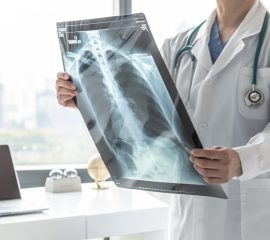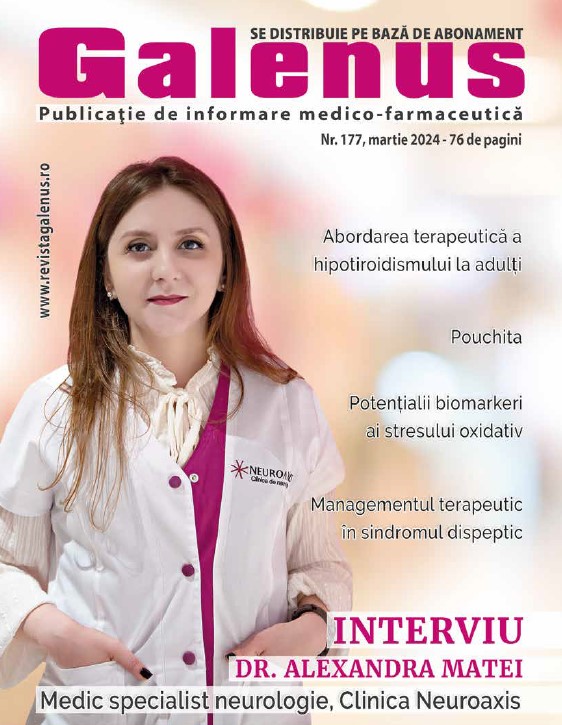Acasă » Practică medicală » Molecular studies of influenza virus A nucleoproteins behaviour
Molecular studies of influenza virus A nucleoproteins behaviour

Rezumat:
Acest articol este un review al datelor din literatura de specialitate cu privire la structura moleculara si comportamentul nucleoproteinelor virsului gripal A. S-a stabilit ca virusul gripal A contine un genom ARN format dintr-un singur lant negativ segmentat. Fiecare segment de ARN este acoperit de multiple copii de nucleoproteine(NP). Structurile de ARN evdentiate prin difractie de Raze X au demonstrat ca aceste nucleoproteine contin domenii bine structurate juxtapose cu regiuni cu densitate electronica redusa corespunzand anselor. Cercetatorii au testat daca aceste anse flexibile au blocat sau au facilitat legarea ARN ului si au Indus de catre ARN oligomerizarea NP. Cercetatorii au ajuns la concluzia ca flexibilitatea anselor 1 si 2 este necesara pentru izolarea si legarea ARNului care implica schimbari conformationale ale nucleoproteinelor.
Cuvinte-cheie: influenza virus A, nucleoproteine (NP),oligomerizarea, genom
Abstract:
This is a review of the literature data on molecular structure and behaviour of influenza virus A nucleoproteins. It has been established that influenza viruses contain a segmented, negative stranded RNA genome. Each RNA segment is covered by multiple copies of the nucleoprotein (NP). X-ray structures have shown that NP contains well-structured domains juxtaposed with regions of missing electron densities corresponding to loops. The researchers have tested if these flexible loops gated or promoted RNA binding and RNA-induced oligomerization of NP.They came up to the conclusion that flexibility of loops 1 and 2 is required for RNA sampling and binding which likely involve conformational change(s) of the nucleoprotein.
Keywords: influenza virus A, nucleoprotein(NP), oligomerisation, genome
Introduction
It has been established that nucleoprotein of Influenza A virus, NP, covers and protects the eight single-stranded viral RNA segments of negative polarity [1,2,3,4,5]. NP assembles with the three subunits of the polymerase into a ribonucleoprotein complex (RNP) which controls transcription and replication. NP has a key role in this complex, regulating the balance between transcription and replication during the virus cycle [6,7,8]. The sequence of NP is highly conserved among virus types and subtypes.
Recently, X-ray structures have shown that NP forms a trimer in the crystalline state [7,9].
The subunit interactions in the trimer were mediated by a swapping tail loop. In particular salt bridges between adjacent monomers were essential for the stability of the trimer; the single point mutation located in the swapping loop, R416A, disrupted the trimer by breaking a salt bridge with E339 of the adjacent monomer and R416A exclusively formed monomers. In the H5N1 structure, the trimer interface was stabilized by an additional salt bridge between K430 of one subunit and E434 of the neighbor subunit [7,9]. The trimer interface also presented hydrophobic patches conferring further stabilization through p2p stacking and hydrophobic interactions [10]. Each NP monomer within the trimer is organized into the head domain, the body domain and the tail loop region.
The head and body domains are well structured and have a high helical content. Some of these helices present a sequence conservation of 80 to 100%. In between the head and body domains, a protruding element (167–186) and a basic loop (72–91) surround a concave groove, rich in basic residues, mostly arginines which likely constitutes the RNA binding site. The electron density in the basic loop was missing in the X-ray structures [7,9, 10,11,12] but the importance of this loop for RNA binding was shown by a substantial decrease of the affinity for RNA of the deletion mutant NP-D74–88 compared to NP [7]. Residues R74, R75 of loop 1 and R174 and R175 of the protruding element were found essential for RNA binding [7].
In their study,Taurs B.et al[1]have questioned the role of the flexible elements found in NP structure in promoting RNA binding and oligomerization.
To that end, they have quantified the flexibility of NP by molecular dynamics (MD) simulations, based on the X-ray structure of the H1N1 protein to which the missing regions have been added. Molecular modeling is an available tool to study protein dynamics, especially of flexible regions unsolved by X-ray crystallography, without the need of labeling high protein concentrations required for NMR studies. The flexibility of the wt protein was compared to the fluctuations of a mutant R361A selected for its location in the RNA binding groove. If the flexibility of the loop regions impacts on the RNA binding groove and mediates RNA binding and protein self-association, differences should be observed between NP and R361A. The simulations highlighted the flexibility of three defined regions in NP monomer that were perturbed either by oligomerization via trimer formation or by the R361A mutation. The first two regions were the basic loop 1 and the protruding element (loop 2) on one face of the protein and the oligomerization loop 3 on the other face of the protein.
The flexibility of loops 1 and 2 facilitated RNA binding to wt NP, presumably mediated by a conformational change of these loops as previously proposed [13]. In contrast, a limited access for RNA binding was seen in R361A, caused by a reduced loop flexibility via a salt bridge between E80 (loop 1) and R208 (loop 2) and hydrophobic interactions between loops 1 and 2 observed in the dynamic simulations. To test this hypothesis, the authors expressed wt NP, wt-E80A-E81A and wt-R204A-R208A on the one hand and the R361A and the triple mutants R361A-E80AE81A, R361A-R204A-R208A on the other hand. The replacement of the two consecutive glutamates or R204A and R208A by two alanines aimed at avoiding the formation of the salt bridge between loops 1 and 2 and at recovering access for RNA binding.
The affinity of these proteins for RNA was determined by surface plasmon resonance and their RNA-induced oligomerization was monitored by dynamic light scattering.
Results
Molecular Dynamics simulations
Tarus B.et al[1] tested (a) the existence of flexible elements included in NP structure and (b) the putative role of these flexible regions in promoting RNA binding and NP oligomerization. They have used NP in both monomer and trimer forms. The simulations first analyzed one NP monomer, based on the available PBD file (2IQH [9]) . The single-point mutation R361A, located in the RNA binding groove, was created from the wt structure and used for testing the relationships between flexibility, RNA binding and RNA-induced oligomerization.
The wt monomer and R361A mutant were simulated over runs of 50 ns for each protein in explicit solvent conditions to insure correct electrostatic interactions in these highly charged proteins. They have calculated the root-mean-square fluctuations (RMSF) of the protein backbone during the dynamics run to identify flexible regions in a quantitative way. They have chosen to represent the fluctuations of the backbone atoms because they are representative of the secondary structures without interference of the interactions between side-chains and solvent.
Comparison between the fluctuations of NP monomer and trimer. The backbone RMSF of NP trimer and of NP monomer were calculated and compared. The existence of three flexible regions in NP monomer which displayed a significantly high RMSF. These regions corresponded to flexible loops, the first two encircling the RNA binding groove, loop 1, also called basic loop (73–90) and loop 2 (200–214) .The third loop corresponded to the oligomerization domain protruding in the neighbor protomer within the trimeric structure (402–428).The flexibility of loops 1 and 2 in each protomer of the NP trimer was very similar to that seen in NP monomer in isolation.
This result allowed at extending the simulation time by reducing the size of the system from trimer to monomer. A large difference of flexibility between the oligomerization loop 3 of the trimer compared to that of the monomer was found. The RMSF value of loop 3 dropping near zero in the trimer is consistent with its good electron density observed in the crystal structure. In contrast, the large flexibility of the oligomerization loop could be expected by the lack of protein-protein interactions in the NP monomer.
Interestingly, the flexibility of the C-terminus of NP trimer was lower than the N-terminus. Indeed, the F488 and F489 of the C terminus were buried within a hydrophobic area in NP trimer.
Comparison between the fluctuations of NP and R361A monomers. The RMSF value decreased markedly in loop 2 while it increased somewhat in loop 1 of R361A compared to loops 1 and 2 of NP monomer respectively . In R361A, the flexibility of loop 3 also presented a relative decrease.
To characterize the interactions between loops 1 and 2, the authors have calculated the minimal distance between loops 1 and 2 observed in the wt and mutated proteins during the dynamics. In the NP, the aperture distance was maximal, ranging between 10 and 15 A ° , large enough for RNA binding. In contrast, this distance was drastically reduced to a value of 2.5 A ° in the R361A mutant, consistent with the formation of strong interactions bridging the two loops, in agreement with the formation of a salt bridge and hydrophobic contacts.
In conclusion, the MD simulations suggested that the flexibility of loops 1 and 2 of NP monomer may be required to grasp RNA and promote RNA binding. This feature was also seen in the trimeric form of NP.
The authors have also expressed loop 2 mutants. The double mutation R204A-R208A aimed at avoiding a compensating salt bridge formation between R204 and E80 or E81. The wt-R204A-R208A mutant exhibited a decrease of ca. eight fold compared to the Kd of wt NP, similarly to the affinity loss of wt-E80A-E81A. However in R361A-R204A-R208A, the protein–RNA interactions were weaker than in R361A.They have assumed that the reduced flexibility of loop 2 and its increased hydrophobicity helped maintaining transient contacts with loop 1 in R361A-R204AR208A despite the rupture of the E80-R208 salt bridge, explaining its low affinity for RNA.
The reduction of the electrostatic interactions by mutation of R208A and R204A at the tip of loop 2 likely will enhance hydrophobic contacts between L79 and W207. Together with compensatory hydrophobic interactions between L79 and A208 and A204 in loop 2- triple mutant, a hydrophobic patch may be established at the tip of loop 2, maintaining transient interactions between E73 and R174 and between R74, R75 and E210 of loop 2, R74, R75, R174 and R175 being essential for RNA binding [5]. In contrast, in loop -1 triple mutant, W207 could not establish hydrophobic contacts with A80 and A81 and the recovery of RNA-binding and oligomerization was facilitated by the larger fluctuation movements of loop1 enhancing RNA sampling.
The R361A-R204A-R208A protein formed oligomers of significantly larger size than those observed with R361A, while R361A-E80A-E81A oligomers were as large as to wt ones within experimental error. Thus, the expected rupture of the E80 – R208 salt bridge by mutation improved RNA-induced oligomerization as compared to that observed in R361A. Interestingly, the wt-R204A-R208A mutant was unable to generate oligomeric species of the same size as NP and the wt-E80A-E81A did.
These data clearly suggested a role of loop 2 inNP oligomerization, in agreement with the largely decreased transcription/replication efficiency of the RNP complex and loss of function [3] by the R208A mutation. Moreover, loop 2 was characterized as part of the bipartite NLS which was shown to be essential for viral replication [9,14]. Thus, a single point mutation, in particular in these loops or in their vicinity as in the RNA groove, may easily shift the NP (folding) energy and affect the path of the NP-NP interactions.
Altogether, the drastic increase of the Kd for RNA and the subsequent altered oligomerization of R361A relative to NP may be mediated by a reduced flexibility of loop 2 and hindrance to access to its RNA binding groove and its vicinity. The R361A mutation did not alter RNA polymerase activity although the virus could not be rescued [4] which suggested that the RNP compensated the effect of the R361A mutation: for example, NP oligomerization rate could be enhanced by one or more protein of the polymerase complex.
The simulations taken together with the experimental data have suggested that flexible loops 1 and 2 are required for NP activity.
Movements of loops 1 and 2 could be part of the NP conformational changes induced by RNA binding.
The authors could not exclude that additional conformational changes may take place in NP in longer timescales. It is likely that the basic loop 1 helps sampling the environment as proposed [5,13].
The oligomerization process of the double mutant wt-E80A-E81A was similar to that of the wt, suggesting that loop 1 was not involved in NP oligomerization.
Once RNA enters the cavity between the two loops, E80 and E81 of loop 1 may confine RNA in the binding groove by electrostatic repulsion.
This suggests that the double mutation may affect RNA dissociation from NP, in agreement with the dissociation rate constants calculated from the SPR.
The importance of the basic loop 1 can be also deduced from epitope mapping of a monoclonal antibody directed against NP [15] that recognized specifically the 71–96 region; another antibody bound to the 1–162 region of NP of 15 Influenza A subtypes [15].
Conclusion
This loops 1 and 2 flexibility deduced from the X-ray structures and studied in this work seems important for NP function and could be exploited by cellular or viral factors to modify or regulate NP activity.
References:
- Bogdan Tarus1, Christophe Chevalier1, Charles-Adrien Richard1, Bernard Delmas1, Carmelo Di Primo2,3,Anny Slama-Schwok1 Molecular Dynamics Studies of the Nucleoprotein of Influenza A Virus: Role of the Protein Flexibility in RNA Binding PLoS ONE | www.plosone.org January 2012 | Volume 7 | Issue 1 | e30038;
- Baudin F, Bach C, Cusack S, Ruigrok RW (1994) Structure of influenza virus RNP. I. Influenza virus nucleoprotein melts secondary structure in panhandle RNA and exposes the bases to the solvent. EMBO J 13: 3158–3165;
- Li Z, Watanabe T, Hatta M, Watanabe S, Nanbo A, et al. (2009) Mutational analysis of conserved amino acids in the influenza A virus nucleoprotein. J Virol 83: 4153–4162;
- Newcomb LL, Kuo RL, Ye Q, Jiang Y, Tao YJ, et al. (2009) Interaction of the influenza a virus nucleocapsid protein with the viral RNA polymerase potentiates unprimed viral RNA replication. J Virol 83: 29–36;
- Ng AK, Zhang H, Tan K, Li Z, Liu JH, et al. (2008) Structure of the influenza virus A H5N1 nucleoprotein: implications for RNA binding, oligomerization, and vaccine design. FASEB J 22: 3638–3647;
- Portela A, Digard P (2002) The influenza virus nucleoprotein: a multifunctional RNA-binding protein pivotal to virus replication. J Gen Virol 83: 723–734;
- Vreede FT, Brownlee GG (2007) Influenza virion-derived viral ribonucleoproteins synthesize both mRNA and cRNA in vitro. J Virol 81: 2196–2204;
- Vreede FT, Jung TE, Brownlee GG (2004) Model suggesting that replication of influenza virus is regulated by stabilization of replicative intermediates. J Virol 78: 9568–9572;
- Ye Q, Krug RM, Tao YJ (2006) The mechanism by which influenza A virus nucleoprotein forms oligomers and binds RNA. Nature 444: 1078–1082;
- Ozawa MFK, Muramoto Y, Yamada S, Yamayoshi S, Takada A, et al. (2007) Contributions of two nuclear localization signals of influenza A virus nucleoprotein to viral replication. J Virol 81: 30–41;
- Abe E, Pennycook SJ, Tsai AP (2003) Direct observation of a local thermal vibration anomaly in a quasicrystal. Nature 421: 347–350;
- Gerritz SW, Cianci C, Kim S, Pearce BC, Deminie C, et al. (2011) Inhibition of influenza virus replication via small molecules that induce the formation of higher-order nucleoprotein oligomers. Proc Natl Acad Sci U S A 108:15366–15371;
- Ng AK, Wang JH, Shaw PC (2009) Structure and sequence analysis of influenza A virus nucleoprotein. Sci China C Life Sci 52: 439–449;
- Li Z, Watanabe T, Hatta M, Watanabe S, Nanbo A, et al. (2009) Mutational analysis of conserved amino acids in the influenza A virus nucleoprotein. J Virol 83: 4153–4162;
- Yang M, Berhane Y, Salo T, Li M, Hole K, et al. (2008) Development and application of monoclonal antibodies against avian influenza virus nucleoprotein. J Virol Methods 147: 265–274.
Fii conectat la noutățile și descoperirile din domeniul medico-farmaceutic!
Utilizam datele tale in scopul corespondentei si pentru comunicari comerciale. Pentru a citi mai multe informatii apasa aici.







